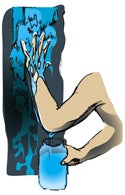Heading out the door? Read this article on the new Outside+ app available now on iOS devices for members! Download the app.

How to find and quickly collect water in the high alpineWhile in Alaska’s Mendenhall Towers last July, my partner and I found ourselves in the warmest weather system in years. For climbers like us hoping to establish new alpine rock routes, the timing was perfect. But with 20-hour days and a desire for light packs, we had a serious challenge finding enough to drink on the walls. Whether you’re running a 5.4 ridge or a 20-pitch alpine 5.12, the dilemma is often the same: how to stay hydrated on the go in alpine terrain.
Sure, water usually flows in snowy terrain on a peak’s lower slopes. But when you head up a long ridge or rock face, dehydration becomes a real issue. That’s why on our Mendenhall climbs, though 1,000 feet of granite separated us from flowing water below, we consistently sought out and utilized snow patches and melt pools, supplementing our H?O supply quickly and easily.
Here are a few techniques I’ve learned/refined that will minimize your pack weight while keeping you hydrated for the crux pitch.
On the ApproachIt doesn’t make sense to save weight on the walk-in with a trimmeddown rack, but then schlep several pounds of water past flowing streams. I use a map, local Beta, or distant views to determine where I can find water on the hike. Will I encounter a moraine stream? Stumble across tarns? Cross beneath a seeping glacier? Rather than haul extra pounds, I’ll stop to drink water when/where it’s flowing. Purifying drops, iodine, or an inline Frontier Pro filter each weigh fewer than two ounces.
Prepping to ClimbIf overnight temperatures won’t drop too far below freezing, collect or melt all your water the pre-climb evening, and ideally have enough already melted in your cookpot for coffee or breakfast. You can also add an electrolyte powder to your drinking water that evening, making it less likely to freeze and making you more likely to drink on route. Meanwhile, if melting dirty or debris-laden snow, reuse a cleaned-out coffee filter to strain out pine needles and spruce beetles (unless you want to include the latter “protein booster”).
What To CarryA dromedary bag becomes smaller as it’s drained, taking up less pack space. However, it’s hard to gather flowing water with only a bag. I’ll also add one wide-mouth bottle per person — total water carried will be about 6.5 liters (including the four-liter dromedary bag for the team). With a goal of drinking four liters each during the day, you and your partner would want to collect an additional liter each while you climb.
Packing Water should represent the heaviest item in your pack and, as such, should sit low in the bag and close to your body. Use a hose system for drinking, which will allow you and your partner to share water and drink with the pack on, reducing the risk of droppage or spillage. Drink from the collapsible bladder first (see above), refilling it with your bottles, which are better suited for collecting drips and snow.
Water-Gathering Techniques Never pass up an opportunity to refill or rehydrate. I’ve learned and employed the following methods to keep myself and my water bottles topped off while climbing.
Belay StrategyBuild belays on ledges that contain snowpatches or seepage. An auto-locking device allows you more easily to collect water or drink from what’s “on tap” while you belay.
The Harvest
When you grab or cut snow chunks to add to your water bottle, collect from the
bottom
edge of a snowfield or serac. This snow is heavily saturated with percolation and will add more water than the same snow volume gathered from above. If climbing across easy ground, harness-clip your bottle and frequently add handfuls of snow to your water, without stopping. On a warm, sunny day, this snow will melt or form a drinkable slush — bring a 7-Eleven straw and some Gatorade powder for a poor-man’s Slurpee.

Curtain Call
Water running down a face in a broad, yet shallow, curtain can be hard to collect. Here’s a trick: remove your jacket and long-sleeved shirt, and then spread and flatten your hand across the rock, giving the wet slab a chest-level “high-five.” The water will collect on your fingers and run down to your elbow in a stream; fill your bottle from this drippage point.

Straw Man
Pocket a straw and a small Ziploc baggy, to collect or drink from drips and puddles. Press your Ziploc against a seeping face, conforming it to the rock. Now fill the baggy, empty it into your bottle, and climb on. Even if you don’t feel thirsty, small pools on route represent some of the quickest and easiest water sources. In cases like this, leave your water bottle packed, pull out the straw, and drink. Another bonus: alpine drips and pristine melt-pools generally don’t require purification, and you can pick up that free straw while restocking your supply of Wendy’s spoons en route to the trailhead.
Blake Herrington’s love of free condiments and Saltines has led him to creatively use straws, spoons, and other gas-station freebies while climbing on three continents. His skill with scarce H2O conditions is ironic, since he lives in the waterlogged North Cascades.
MORE TECH TIPS: